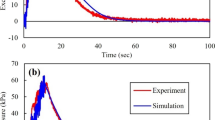Abstract
This study discussed how cavity gas pressure affects the stability of rock mass with fractures under well controlled laboratory experiments. Suddenly-created void space created and the induced gas pressures have been the focus of active researches because they are associated with fast movement of large-scale landslides. A shaking table experiment was set up to mimic weak-intercalated rock slope under seismic loads. Excessive cavity gas pressure would be produced in weak spots upon a sudden vibration load. The drastically elevated gas pressure is believed to be responsible for the creation of cavities surrounding the tension fracture. With dissipation of the excessive cavity gas pressure, the fractures are in unbounded closed-state. This observation explains that the slope body would be split and loosened under several aftershocks, and with the expanding of the cracks, the slope failure eventually occurred. The research of the mechanism of cavity gas pressure could provide a novel insight into the formation mechanism of landslides under seismic load and has implications for the disaster prevention and control theory for the slope stability evaluation.
Similar content being viewed by others
References
Aлbтшyлep AB, Балабанов AB и др (1970) X-ray study of the initial development stage of underground explosive cavities in sandy soil. Φ.Γ.B., 6, 4. (In Russion)
Cheng QG, Pang JB, Hu GT, et al. (1999) Dynamics of Rockslide Avalanche. Southwest Jiao tong University Press, Chengdu, China. pp 1–7. (In Chinese)
Han WJ, Liu SY, Zhang WD (2011) Experimental study of pneumatic fracturing effect in soil under overburden load. Rock and Soil. Mechanics 32(7): 1951–1956. DOI: 10.3969/ j.issn.1000-7598.2011.07.006 (In Chinese)
Hu GT, Dai HL (1995) Rockslide Dynamics. Geological Press, Beijing, China. pp 16–22. (In Chinese)
Huang RQ, Pei XJ, Li TB (2008) The Basic Characteristics and Formation Mechanism of Daguangbao Large-scale Landslide Triggered by “Wenchuan” earthquake. Journal of Engineering. Geology 16(6): 730–741. DOI: 10.3969/j.issn.1004-9665.2008. 06.002. (In Chinese)
Huang RQ, Pei XJ, Li WF, et al. (2009) Further examination on Characteristics and Formation Mechanism of Daguangbao Landslide. Journal of Engineering. Geology 17(6): 725–736. DOI: 10.3969/j.issn.1004-9665.2009.06.001 (In Chinese)
Kent PE (1974) The transport mechanism in catastrophic rock falls. The Journal of. Geology 74(1): 79–83.
KoлoκoB OC, ТихомироВ AM, Щалукевец AФ (1967) Boiler cavity development at explosion in sandy soil. Φ.Γ.B., 3, 4 (In Russion)
Lao J, Xiao WG, Wang XJ, et al. (2009) Numerical simulation on underground cavity-decoupling explosion. Explosion and Shock. Waves 29(5): 536–541. DOI: 10.3321/j.issn:1001-1455.2009.05.015 (In Chinese)
Liu HC, Zhang ZY (1986) Near Long yangxia over consolidated clay landslide formation mechanism and high speed sliding reason. Journal of Chengdu Institute of. Geology 13(8): 94–104. (In Chinese)
Liu LC, Su ZP (2010) The steady-state response of cavity. Journal of Central South University of Forestry and. Technology 30(8): 104–107. DOI: 10.3969/j.issn.1673-923X. 2010.08.021. (In Chinese)
Long Y, Lin XS, Xu LP (1988) Experimental study on linear charge blasting in soil cavity development process. Explosion and Shock. Waves 8(3): 227–235. (In Chinese)
Lu WN (1991) Airo-dynamic approach to sliding problems of high landslide. Journal of Xi’an Geological. Institute 13(4): 77–85. (In Chinese)
Shreve RL (1968) Leakage and fluidization in air-layer lubricated Avalanches. Geological Society of America. Bulletin 79(5): 654–657. DOI: 10.1130/0016-7606(1968)79
Xu LP, Jin H, Zhang PD (1982) Development of Explosion Cavity in Soil. Chinese Journal of Theoretical and Applied. mechanics 5: 500–504. (In Chinese)
Xu XN, Li SW, Wang XQ, et al. (2013) Characteristics of Formation Mechanism and Kinematics of Daguangbao landslide Caused by “Wenchuan” earthquake, Sichuan, China, Chinese Journal of Engineering. Geology 21(2): 269–281. DOI: 10.3969/j.issn.1004-9665.2013.02.013 (In Chinese)
Xu ZM, Huang RQ, Tang ZG (2007) The engineering geological characteristics of the Touzhai landslide and its mechanism. Geological. Review 53(5): 670–691. DOI: 10.3321/j.issn:0371-5736.2007.05.014 (In Chinese)
Yin YP (2009) Rapid and long run-out features of landslides triggered by the Wenchuan earthquake. Journal of Engineering. Geology 17(2): 153–166. DOI: 10.3969/j.issn.1004-9665.2009.02.002 (In Chinese)
Zhang J, Wang XQ, Wang LS, et al. (2013) Physical simulation on the formation mechanism of the Daguangbao landslide. Hydrogeology Engineering. Geology 40(3): 59–62. (In Chinese)
Zhang WD, Liu SY, Gu CY, et al. (2009) Model tests on pneumatic fracturing in soils. Chinese Journal of Geotechnical. Engineering 31(12): 1925–1929. (In Chinese)
Author information
Authors and Affiliations
Corresponding author
Additional information
http://orcid.org/0000-0003-2402-7104
http://orcid.org/0000-0002-0702-9135
http://orcid.org/0000-0003-0929-8432
http://orcid.org/0000-0002-3185-4741
Rights and permissions
About this article
Cite this article
Wang, Xq., Chen, Zl., Zhou, Z. et al. Variation of cavity gas pressure in slopes with weak intercalation under seismic load. J. Mt. Sci. 13, 352–360 (2016). https://doi.org/10.1007/s11629-014-3148-4
Received:
Accepted:
Published:
Issue Date:
DOI: https://doi.org/10.1007/s11629-014-3148-4




